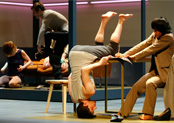OPERA SEARCH

Nijinskys Tagebuch
(Nijinsky's Diary) (2007/08)Text adapted by Carolyn Sittig based on the diaries by Waslaw Nijinsky, in the German translation by Alfred Frank (G)
S,Bar,2actors(f/m),2dancers(f/m); rec(S,T).ob(=corA).ssax.bn(=dbn)-hn(natural).trbn-perc(1):dr set(2tom-t[sm,lg]/wdbl/susp.cym/SD/BD)/vib/timp/tam-t/flexatone/t.bells-pft(=synth,hpd)-gtr-vlnI(also amplified).vlnII.vla.vla da gamba.db
Abbreviations (PDF)
Bote & Bock
Theater, Aachen
Ludger Engels, director
Conductor: Daniel Jakobi
Company: Theater Aachen
Nijinsky’s Diary is not an opera but is rather a mixture of prose, melodrama and musical theatre. It is based on excerpts from diaries by Waslaw Nijinski, written between January 19, 1919 and March 4, 1919, after his last public performance and before his admission to a psychiatric hospital.
The selected passages represent themes and stylistic features typical of these diaries. Nijinsky’s style remains completely unchanged, even under the influence of his nascent schizophrenia. While the order of a few sections was re-arranged and a very small number of sentences were shortened, chronological order still forms the basic structure of the text.
Along with allusions to everyday life, the themes featured in the texts include memories, future visions, poems, puns and the disintegration of language. Specific and trivial incidents are juxtaposed with metaphysical or naive reflections. A particularly fascinating aspect of these diaries is the fact that they are a record of the early stages of Nijinski’s schizophrenia, a written comment on the condition under which he is writing.
The text is not treated as an individual voice in the composition but divided up among six actors who all represent Nijinsky, or his speaking self. In the course of the work, they increasingly superimpose each other, musically remodelling the intellectual loops and spirals that are so characteristic of the diaries.
Thomas Tangler
“This premiere at the Aachen Theatre was an unqualified success, depicting the psychological crisis in its purest form... The audience at the premiere followed the composer unanimously on this unfamiliar journey... Glanert carries the split personality to extremes, in that the character of Nijinsky is split as if into six figures portrayed by two singers, two actors and two dancers, all of whom are required to exceed their performing abilities. In this piece, Glanert’s music is tougher and more abrupt than in previous works to date... Cool cluster blocks alternate with pleasant musical echoes, grotesque dislocated sounds with tonal songs of fine poetry.” (Pedro Obiera, Gießener Allgemeine, 07 Apr 2008)
“How does a composer write music to match such a journey into the inner psyche? Glanert’s solution is a highly differentiated, diversified soundworld... Formally and dramatically, everything is well-considered, written with a sure hand, the text structured with composed loops always driving forward... Three instrumental interludes giving the impression of the trauma, with embedded elements of dance and jazz, introduce a naive-cheerful note almost as a reminiscence motif... A well-crafted music theatre piece.” (Gerhard Rohde, Frankfurter Allgemeine, 08 Apr 2008)
The libretto of the work "Nijinskys Tagebuch" (Nijinsky’s Diary) consists of excerpts from Vaslav Nijinsky’s diaries, which he kept between 19 January 1919 and 4 March 1919, after his final public appearance in St. Moritz and before being committed to an asylum.
The selected text passages incorporate all the subjects and stylistic characteristics typical of these diaries, whereby Nijinsky’s style of writing under the influence of his incipient schizophrenia is faithfully preserved. A few passages of the text have been rearranged, a very few sentences have been slightly abridged, but the continuous chronology has been retained as the basic structure of the text that is to be set to music.
Alongside descriptions of everyday occurrences, the diaries contain memories, visions of the future, poems, and puns, and give witness to the degeneration of speech; alongside concrete and banal experiences are found the metaphysical and the naive. What is fascinating about these diaries is the minute-by-minute record of the schizophrenia, as a commentary already at the instant of writing.
In the composition, the text is not individualized, but rather divided among six performers who all represent Nijinsky or his speaking self; this results in increasing superimpositions and the musical imitation of the looping and spiraling thoughts that are so characteristic of the diaries.
There are no mandatory specifications for the stage design or the stage direction. On the contrary, the text as it appears in the score should be freely recreated, without lapsing into simple illustration. Nevertheless, direct concretisms can and should by all means be included in the presentation, even to demonstrate its disintegration.
Each of the six performers has a range of tasks that exceeds the usual norms: singers and dancers are also required to speak, the actors sometimes also have to sing; the singers are called upon to assume a markedly theatrical style that also includes improvisation, while the actors are often subject to the dictates of the score, and must therefore relinquish some of their autonomy. The dancers, as the starting point of the concept of motion, are associated with the act of writing; they are also entrusted with the fashioning of the instrumental interludes. Having the singers and actors dance is likewise conceivable within the framework of the overall concept; however, a re-creation of the historical Nijinsky and his personal style of dancing would be unwelcome, since it is not the story, but the text of the diary that stands in the foreground here.
The stage director is thus called upon in this piece to overstep and to form the boundaries in the sense of a dream theater; each performer should grow into the discipline of his/her counterpart, up to and including an imaginable fusion and separation of a sixfold body, a sixfold voice.
The instrumental scoring corresponds to the heterogeneity of the character to be portrayed and of the text: Baroque, conventional, and modern instruments, which also represent the different temporal layers, form an ensemble that fathoms the open spaces of the unspeakable, inexpressible, and nameless, for the melodramatic, the through-composed, the recitative-like, for dance, speech, song, and silence.
(Preface of the score)
Dramatic
